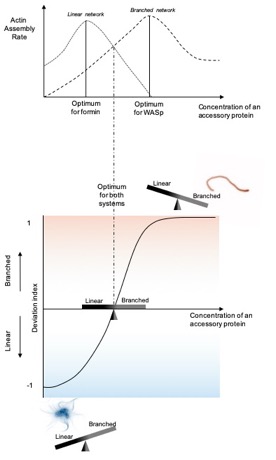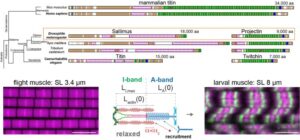The team of Alphée Michelot publishes in Plos Biology a study demonstrating how cells control the size of multiple actin networks within a common cytoplasm.
 Eukaryotic cells assemble a variety of actin structures from identical actin molecules. Actin structures coexist within a common cytoplasm and power diverse cellular functions. Precise size control of individual actin networks is crucial so that functions are performed optimally without any excessive actin assembly. Understanding the basic principles of balanced actin assembly is critical to explain many cellular processes that require major, rapid reorganizations of the actin cytoskeleton such as epithelial-mesenchymal transitions. Such processes are linked with a fine-tuning of the actin regulators that can tip the actin network balance and where any biochemical disorder may play fundamental role in cancer development.
Eukaryotic cells assemble a variety of actin structures from identical actin molecules. Actin structures coexist within a common cytoplasm and power diverse cellular functions. Precise size control of individual actin networks is crucial so that functions are performed optimally without any excessive actin assembly. Understanding the basic principles of balanced actin assembly is critical to explain many cellular processes that require major, rapid reorganizations of the actin cytoskeleton such as epithelial-mesenchymal transitions. Such processes are linked with a fine-tuning of the actin regulators that can tip the actin network balance and where any biochemical disorder may play fundamental role in cancer development.
A major question in the field was to understand how cells can simultaneously control the size of multiple actin networks sharing a common pool of regulatory proteins. To predict how two distinct networks of actin filaments control their size in a common environment, the team has developed a minimal biomimetic assay allowing for the simultaneous assembly of Arp2/3-branched networks and formin-linear networks of actin filaments. Results indicate that accessory proteins generally affect the assembly rates of both networks differently. However, a basic interpretation of these assembly rates was not enough to explain a number of phenotypes that were obtained in a simple cellular model (i.e. yeast, which has only one linear and one branched actin networks), where the activity of the same actin regulatory proteins was tuned. For example, a decreased rate of actin assembly of both networks under certain conditions could very well lead to a normal organization of the actin cytoskeleton.
The team has demonstrated that an appropriate interpretation of these results is only possible when the assembly rates of both networks are compared relatively to each other. Their results confirm that the different actin networks in cells do not assemble independently, but compete with each other for the assembly of actin, and that only a global interpretation at the scale of all the actin networks of the cell makes sense.
Therefore, this article proposes a general model for the control of actin network size in cells. It thus offers to the community a new perspective to understand how complex actin cytoskeleton reorganizations can occur during major cellular transitions.
To know more :
-
Sizes of actin networks sharing a common environment are determined by the relative rates of assembly.
Adrien Antkowiak, Audrey Guillotin, Micaela Boiero Sanders, Jessica Colombo, Renaud Vincentelli, Alphée Michelot



